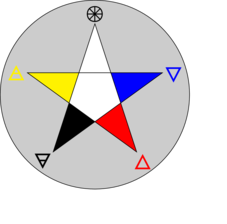J. Daniel Gunther’s Initiation in the Æon of the Child
 Initiation in the Æon of the Child
Initiation in the Æon of the Child
Ibis Press
2014
223

J. Daniel Gunther’s Initiation in the Æon of the Child: The Inward Journey is pretentious and difficult. The reader is expected to have, at minimum, the ability to read common Hebrew words (e.g., God and angel names) without transliteration and to have a fairly extensive background in the Western Magickal Tradition, qabalah, and Thelema.
The author often makes a point with subtle, but unexplained symbolism, only to end the paragraph with “This is all very technical and of interest only to aspirants of the A∴A∴” (p. 36) or “This impression is false and therein lies a Mystery” (p. 48). While the book is filled with references and footnotes, Gunther often makes sweeping generalizations without any supporting evidence. For example:
Christianity is ultimately built upon an archetypal fear of the dark. In primitive man, the boundary between the unconscious and consciousness was very tenuous. (p. 32)
These assertions likely have their origin in Jung’s ideas about the collective unconscious and the association between a child’s connection with her mother and her fear of the dark. But projecting these ideas onto “primitive man” is speculation. Unfortunately, Gunther often makes assertions like this, giving the reader pause to consider if the assertion is true or applicable. This makes the book less an informative explanation of the A∴A∴ and more an attempt at creating a religious text. This might be the goal, given that the book has a “Class B” imprimatur, which was lacking in both Shoemaker’s and Eshelman’s more modest (and more readable) books.
The real difference, though, between this book and the other two is that both Shoemaker and Eshelman seek to teach the reader, whereas Gunther’s goal seems to be to impress the reader. At this he succeeds! Gunther clearly has a command of Western magickal symbolism, with frequent pages that simultaneously contain Hebrew, Greek, Coptic, and Egyptian hieroglyphics — all presented with impressive topography, supporting footnotes, and illustrative figures. The end of the book includes a glossary and an extensive bibliography.
But Gunther never writes a simple sentence when a few complex paragraphs will do, never uses a common word when an uncommon one will dazzle, and never states something plainly when there is opportunity for obfuscation. For example, Chapter 5 starts out as if it will explain why Tzaddi is not the Star. The chapter includes a discussion of stars, fish, and fish-hooks and then moves into an analysis of Fixed Mercury, Perfected Salt, and Perfected Sulfur. Finally, the rationale for Tzaddi being Aries and Heh being Aquarius “becomes clear” (p. 113) about half-way through the chapter — to some reader, but, alas, not to this reader.
I cannot recommend this book for beginners, but I suspect that reading it again in a few years, after much study, will bear more fruit than after my initial reading.
Gunther is associated with the Outer College of the A∴A∴ (outercol.org). He does not discuss his initiation lineage in this book.

One thought on “J. Daniel Gunther’s Initiation in the Æon of the Child”
Thanks for the review! So far, so good, for me with Eshelman.